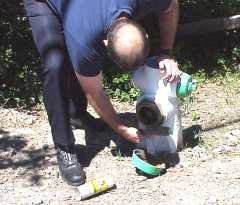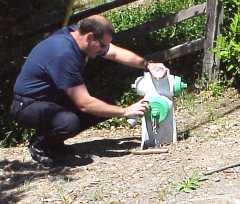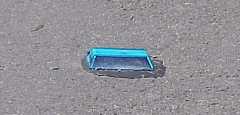© 2001 Capt. Willis Lamm, Water Supply Officer, Moraga-Orinda (CA) Fire District |
| PROCEDURES, Continued |
|
Caps and Chains
Caps should be free from cracks and turn freely. Chains should be attached to caps and the hydrant body and turn freely in the cap chain race. Crews should clean and lubricate threads and lubricate the chain race on the cap as needed. Missing caps should be replaced. Valves Valves should open and close properly and shouldn't leak at either the stem or the nozzle. Leaky packings on older hydrants should be tightened. Valves that are difficult to operate, have bent stems or don't open and close fully should be reported. Paint Paint should be in good condition. Hydrants with chips or rust showing should be touched up with aerosol paint. Hydrants in severe need of repainting should be reported. Bodies should be the correct color (which in our district is white for municipal hydrants, yellow for private and yard hydrants and red for special operation hydrants, draft hydrants and hydrants on "dry" systems which have to be supplied via a FDC.) |
Cleaning threads with a wire brush
|
|
Color Code
Bonnets and caps should be the appropriate color for the operating range of the hydrant. Blue Reflector The blue reflector should be relatively clean and reflective. At least 2/3 of its reflective surface should be intact and in good condition. Severely damaged or missing reflectors should be reported. Gate Pot The gate pot for the street shutoff valve should be accessible and readily discernible from water main zone valves. All hydrant gate pots should be painted white in order to be easily spotted under water if a hydrant gets knocked off. Any gate pots which cannot be located should be reported. Curb Paint Curb paint involves two issues. One is a "red zone" painted on the curb where appropriate. The other indicates the distance from the curb to the street valve which is painted in contrasting roman numerals. Missing red zones or numerals should be reported. Markings Markings are indicators on the hydrant bodies of special conditions such as a hydrant on a regulator zone or a dead end main. Markings shown on the checklist that do not appear on the hydrant should be reported. Continue to Part ThreeReturn to Part One |
The blue reflector should bevisible whether on the roadway or over on the shoulder 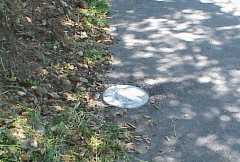 had been covered with "slurry seal" 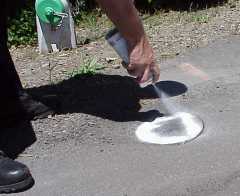 |
Return to Water Supply Index
Back to Information Section
For Related Information, Check out:
Where's the Hydrant?
|
Unless otherwise noted, all contents of these WWW pages © 1996-2002, FireHydrant.org |
